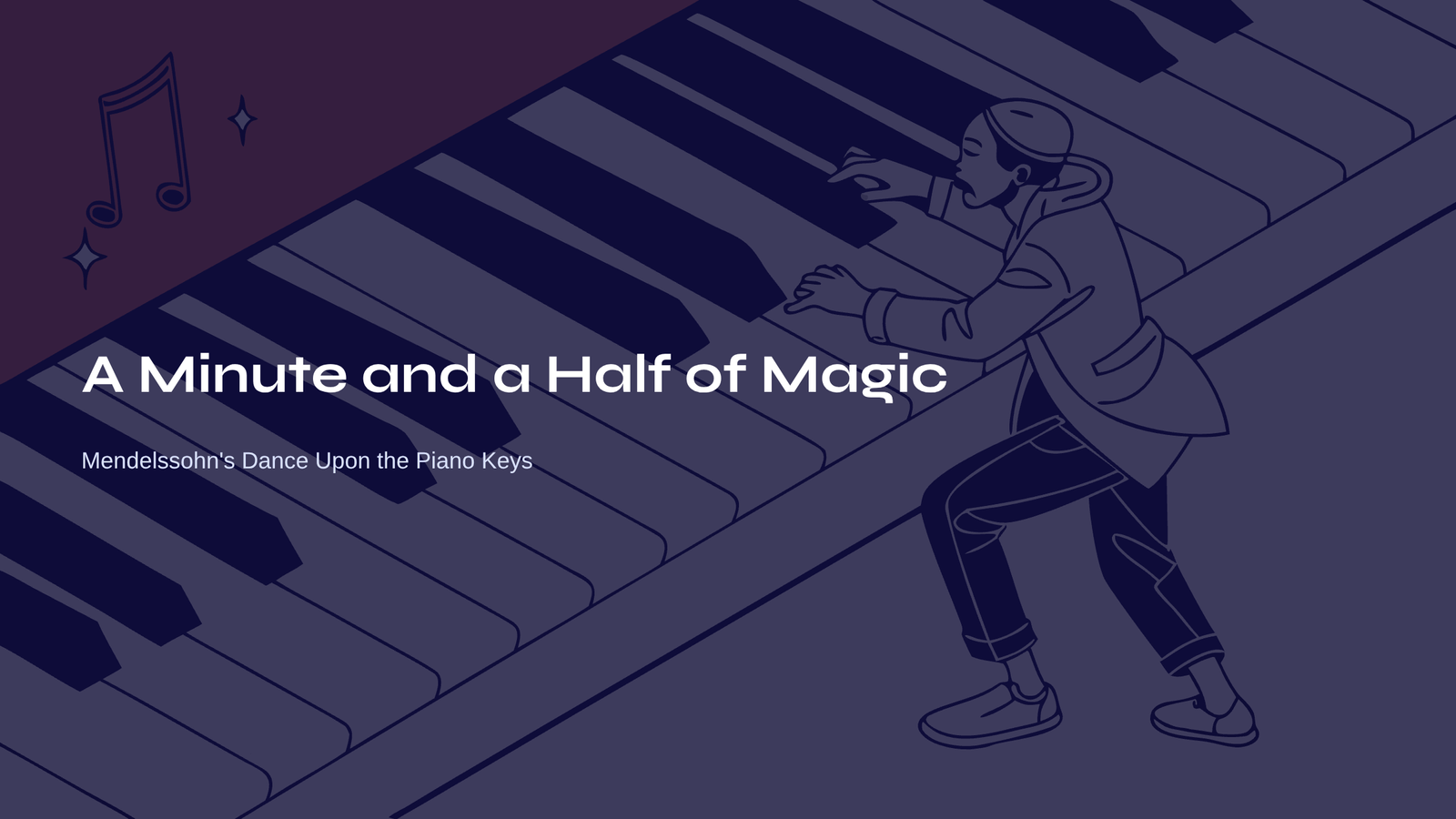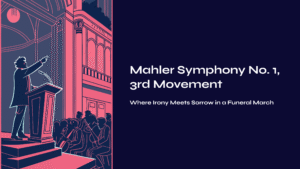Table of Contents
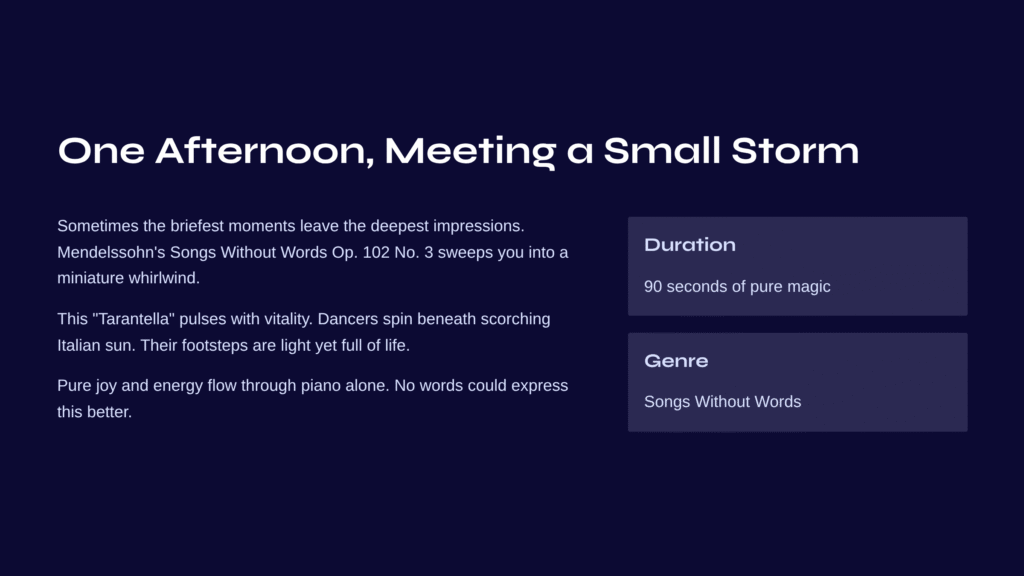
One Afternoon, Meeting a Small Storm Above the Piano Keys
Sometimes the briefest moments leave the deepest impressions. When I first heard Mendelssohn’s Songs Without Words Op. 102 No. 3, I felt as though I had been swept into a miniature whirlwind for exactly one minute and thirty seconds. This “Tarantella” unfolding across the piano keys is quite literally dancing music. The sounds created by fingers gliding across the keyboard pulse with the same vitality as dancers spinning beneath the scorching Italian sun, their footsteps light yet full of life.
Listening to this piece, you instantly understand why Mendelssohn created the genre of “Songs Without Words.” Here is pure joy and energy that no words could possibly express, conveyed perfectly through the piano alone.
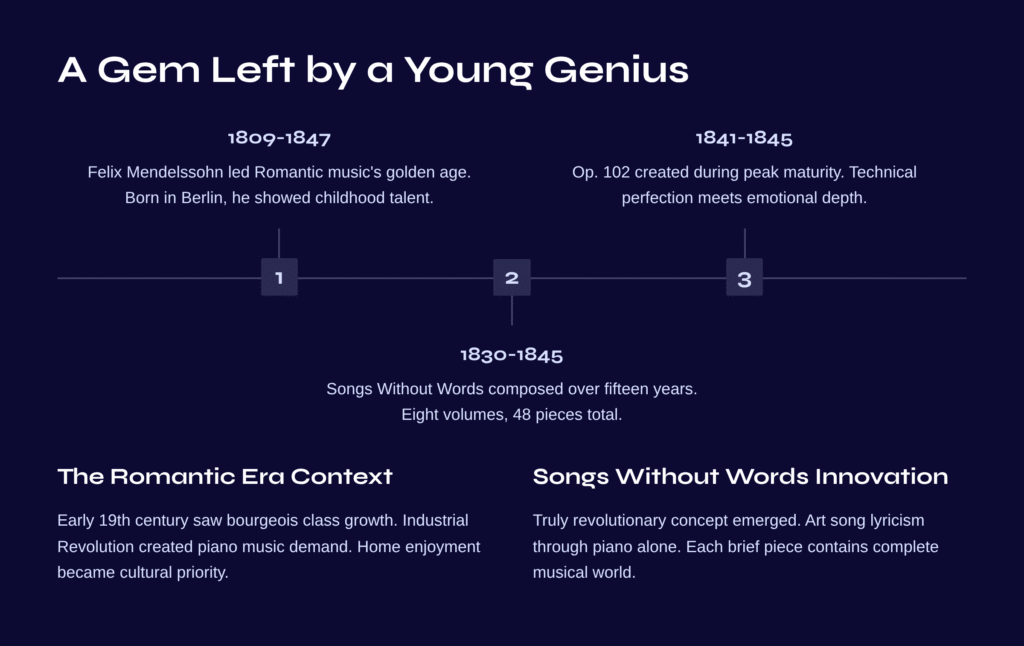
A Gem Left by a Young Genius of the Romantic Era
Mendelssohn and His Time
Felix Mendelssohn (1809-1847) was among the composers who led the golden age of Romantic music. Born into a prosperous Berlin family, he displayed musical talent from childhood, showing particular originality in piano composition. The early 19th century during which he lived was a time when the bourgeois class grew alongside the Industrial Revolution, creating unprecedented demand for piano music suitable for home enjoyment.
The Birth of Songs Without Words
Mendelssohn’s “Songs Without Words (Lieder ohne Worte)” represented a truly innovative concept. This genre, meaning literally “songs without lyrics,” attempted to express the lyricism of art songs through piano alone. The complete collection of eight volumes containing 48 pieces was composed over fifteen years from 1830 to 1845, with each brief composition containing a complete and highly refined musical world.
Op. 102, the final eighth volume, was composed between 1841 and 1845, during the peak of Mendelssohn’s musical maturity. This period saw the birth of works where technical perfection and emotional depth achieved perfect harmony.
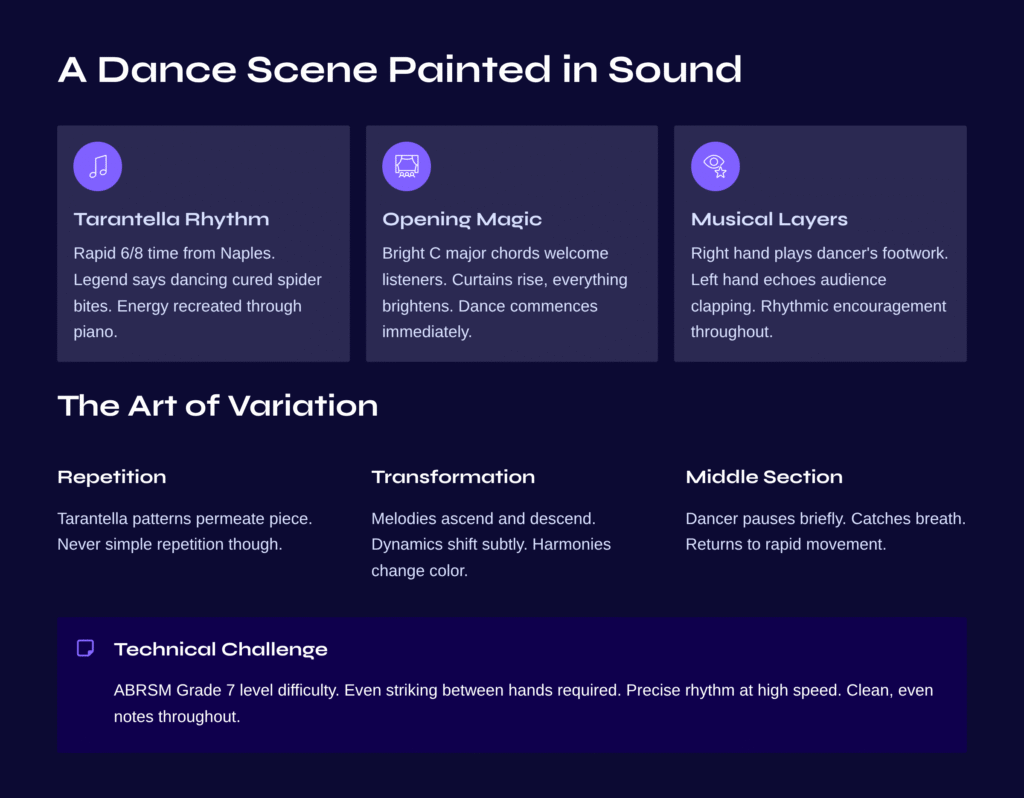
A Dance Scene Painted in Sound
The Magic of Tarantella Rhythm
The heart of this piece lies in its tarantella rhythm. The tarantella, a traditional dance from southern Italy’s Naples region, moves in rapid 6/8 time and originates from the legend of people dancing frantically to cure spider bites. Mendelssohn perfectly recreated this legendary dance’s energy through the piano.
The moment the piece begins, bright and clear C major chords welcome us. Like curtains rising on a stage, everything suddenly brightens as the dance commences. The rapid melody played by the right hand resembles a dancer’s light footwork, while the left hand’s accompaniment echoes the clapping and rhythmic encouragement of an enthusiastic audience.
The Exquisite Balance of Repetition and Variation
The repetitive rhythmic patterns characteristic of tarantella permeate the entire piece. Yet this is no simple repetition. As melodies ascend and descend, dynamics subtly shift, and harmonies change color moment by moment, creating varied expressions like a dancer showcasing different movements.
Particularly noteworthy is the small variation appearing in the middle section, which feels like a dancer pausing briefly to catch their breath. But soon the original rapid movement returns, maintaining its energy until the very end without flagging.
The Precision of Piano Technique
While the score appears deceptively simple in C major, actual performance demands considerable skill. Even striking between both hands, maintaining precise rhythm at high speed, and above all, producing every note cleanly and evenly – these technical challenges explain why this piece is classified at ABRSM Grade 7 level.
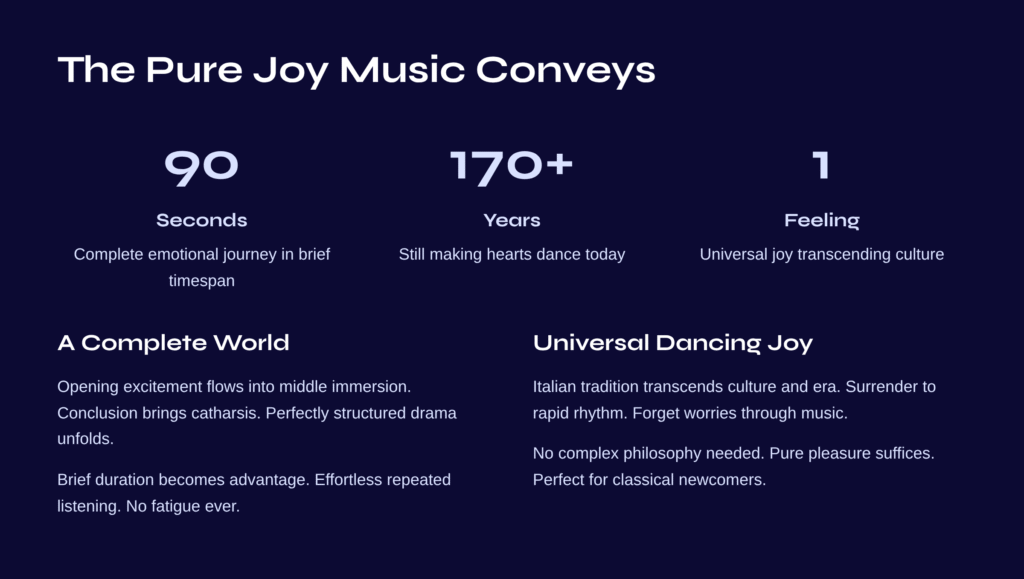
The Pure Joy Music Conveys
A Complete World Within One Minute and Thirty Seconds
The most remarkable aspect of this piece is experiencing a complete emotional journey within such a brief timespan. From the excitement of the opening through the immersion of the middle section to the catharsis of the conclusion, it’s like watching a perfectly structured drama unfold.
Some days I find myself unconsciously swaying to this piece’s infectious energy. Other days I marvel at Mendelssohn’s genius, listening repeatedly to the same composition. The brief duration of one minute and thirty seconds becomes an advantage, allowing effortless repeated listening without fatigue.
The Universality of Dancing Joy
Though the tarantella represents an Italian traditional dance form, the joy this music conveys transcends culture and era. The impulse to surrender to rapid rhythm, the desire to forget all worries while swept away by music – these represent universal human instincts.
This piece demands no complex philosophy or deep contemplation. Simply opening your heart to music’s pure pleasure suffices. This makes it an ideal recommendation even for classical music newcomers.

Small Secrets for Deeper Listening
Comparing Individual Performers’ Personalities
The same piece can feel completely different depending on the performer. Daniel Barenboim’s 1974 recording reveals intense energy within restrained elegance, while Alicia de Larrocha’s performance demonstrates the passionate vitality befitting her Spanish heritage. Jeffrey Biegel’s contemporary interpretation feels like a modern reinterpretation of tarantella’s primitive energy.
Comparing different performers’ versions offers a special way to enjoy this piece, with each interpretation revealing new facets worth discovering.
The Importance of Listening Timing
This piece affects us differently depending on time of day and circumstances. Morning listening provides energy to start the day, while during brief work or study breaks it offers perfect mood refreshment. Evening listening delivers refreshment that sweeps away daily fatigue.
Connections to the Complete Songs Without Words Collection
This tarantella is particularly famous for its vibrant character within Mendelssohn’s Songs Without Words collection. Unlike other songs that tend toward lyrical and introspective qualities, this piece is extroverted and dynamic. Even within the Op. 102 collection, it creates strong contrast with other pieces, functioning like sudden laughter interrupting quiet conversation.
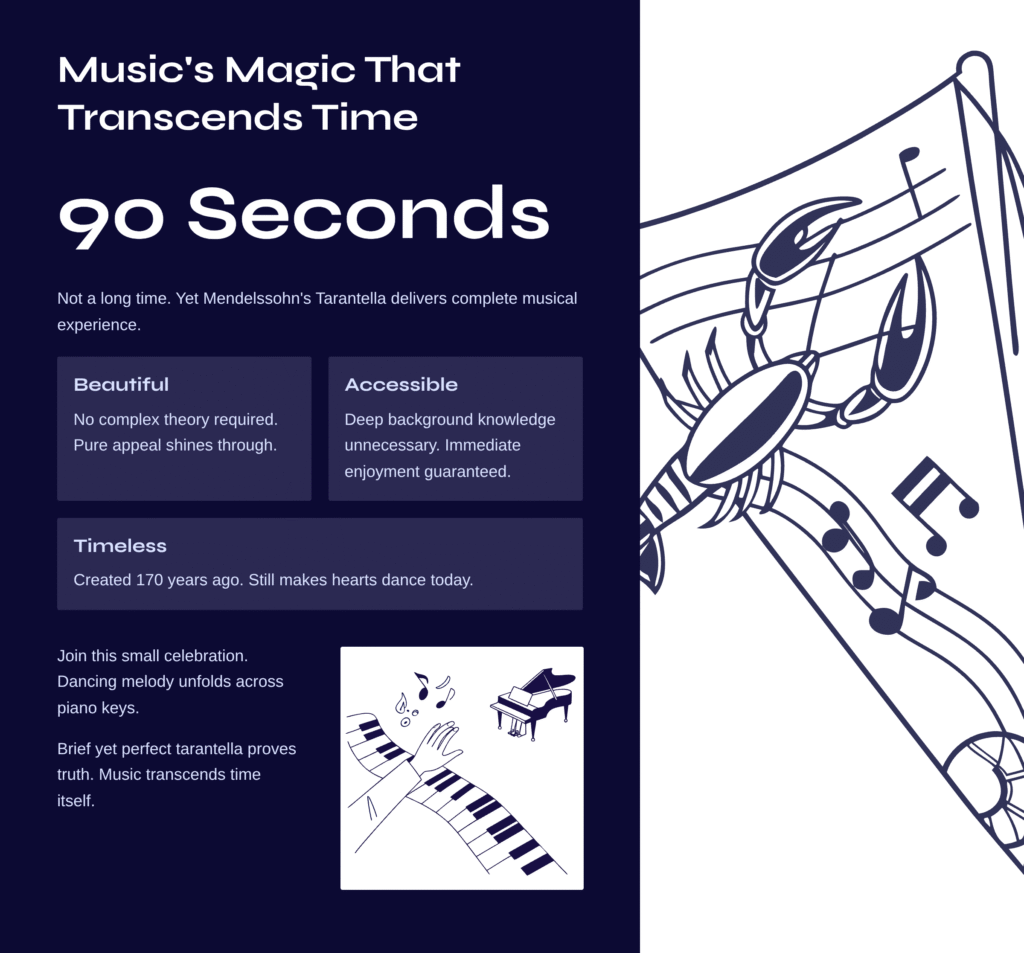
Music’s Magic That Transcends Time
One minute and thirty seconds. Not a long time. Yet Mendelssohn’s Tarantella delivers a complete musical experience within this brief span. Beautiful and enjoyable without requiring complex theory or deep background knowledge, this work demonstrates classical music’s purest appeal.
Join this small celebration unfolding across piano keys. The dancing melody Mendelssohn created over 170 years ago continues to make our hearts dance today. This brief yet perfect tarantella proves the truth that music transcends time itself.
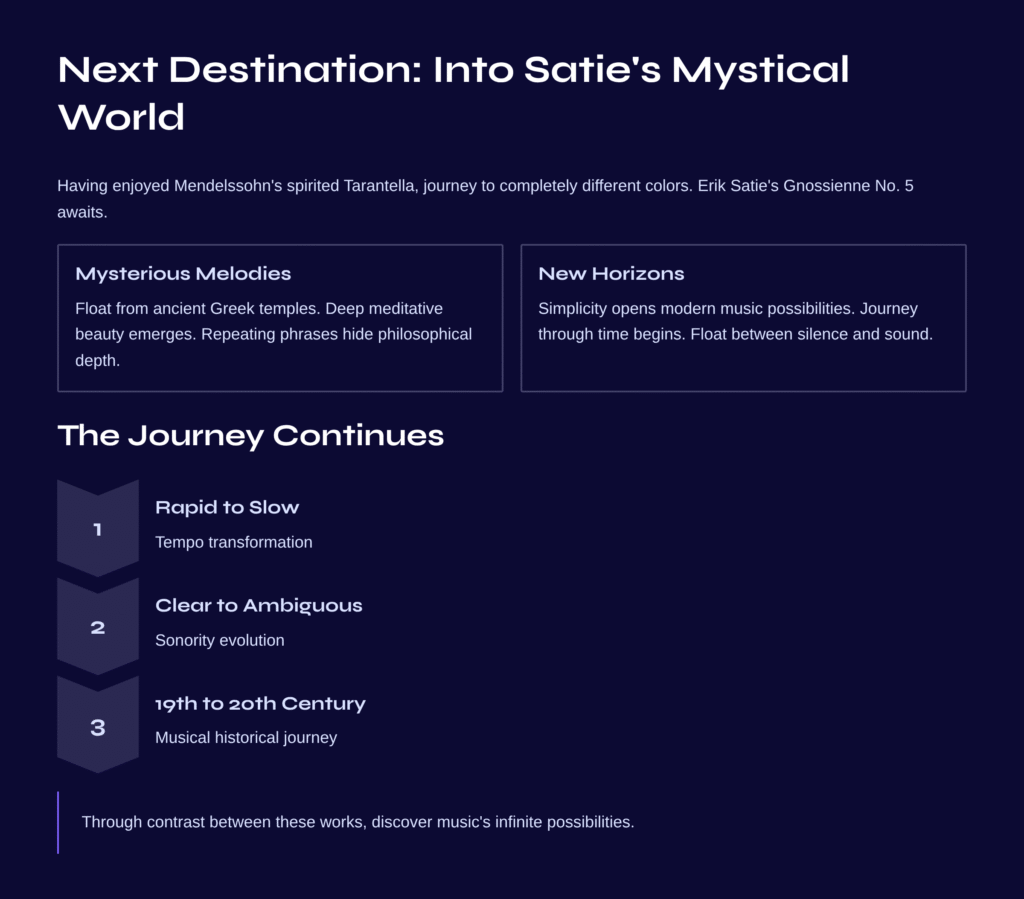
Next Destination: Into Satie’s Mystical World
Having enjoyed Mendelssohn’s spirited Tarantella, why not journey to music of completely different colors? Erik Satie’s Gnossienne No. 5 offers attractions opposite to Mendelssohn’s extroverted energy.
Satie’s Gnossienne resembles mysterious melodies floating from ancient Greek temples. The deep meditative beauty hidden within repeating phrases and the philosophical depth contained in simplicity opened new horizons in modern music. If Mendelssohn’s Tarantella was a vibrant dance of musical notes, Satie’s Gnossienne represents a journey through time, floating between silence and sound.
From rapid to slow tempo, from clear tonality to ambiguous sonorities, from the 19th to the 20th century – embark with me on this musical historical journey. Through the contrast between these two works, you’ll discover music’s infinite possibilities.
I hope this writing helps you understand and enjoy Mendelssohn’s Tarantella more deeply. Music is living art that offers different emotions to each listener. Create your own special listening experience.
